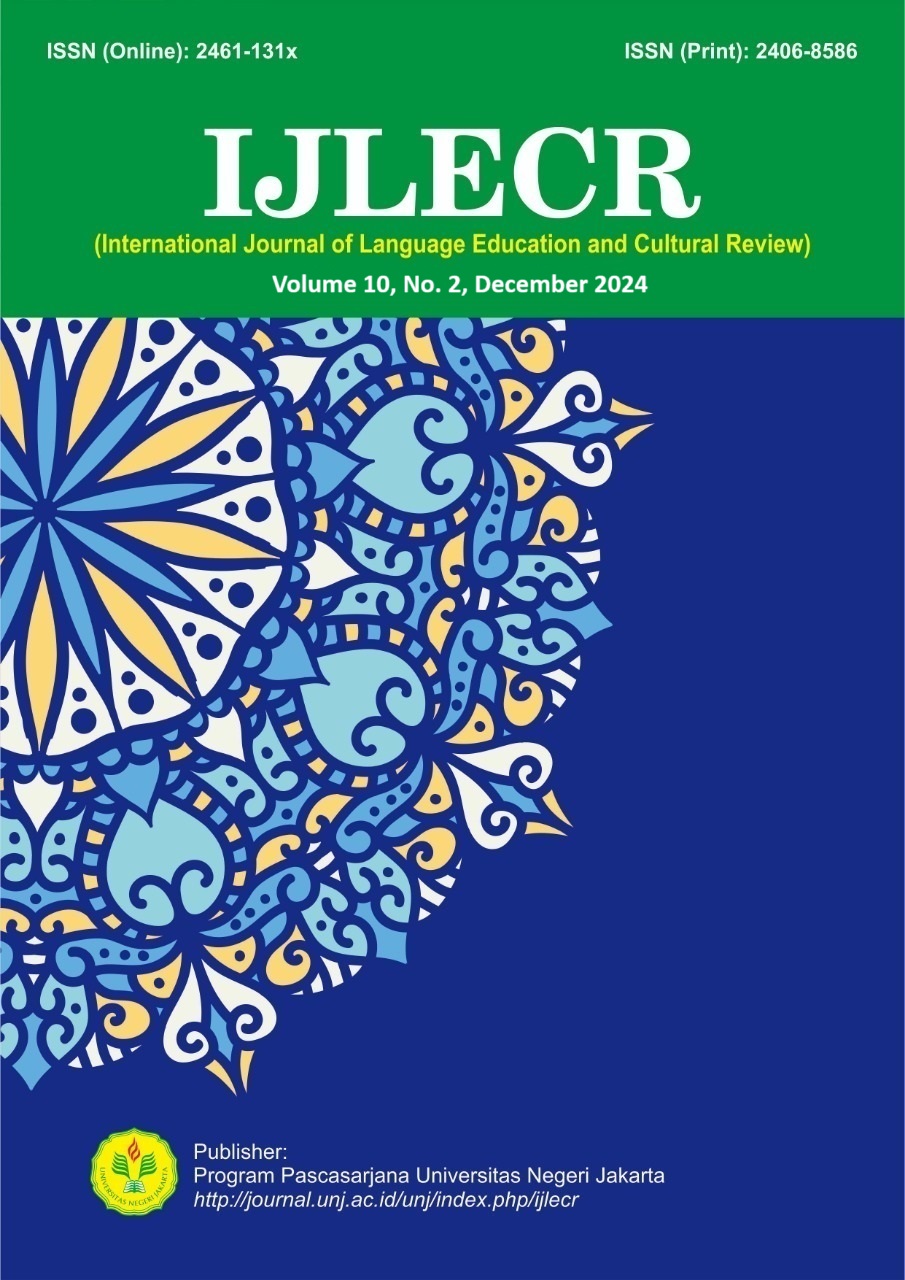Enhancing Students' Ability to Write Personal Experiences in Sundanese Language through a Contextual Learning Approach
DOI:
https://doi.org/10.21009/ijlecr.v10i2.39800Kata Kunci:
Writing Ability, Contextual Approach, Personal Experiences, Sundanese LanguageAbstrak
Learning to write by using Sundanese language in Junior High School get to attention from Sundanese teacher. When learning to write personal experience, students always feel difficult especially in using language. The most of result, students writing problems are spelling, punctuation and diction of Sundanese language. This research to increase students’ skill in writing personal experience through contextual approach. The method used in this research was classroom action research by combining qualitative and quantitative data and following Kemmis & Taggart’s research model approach, which consists of 4 stages in each cycle, i.e., planning, action/implementation, observation, and reflection. Qualitative data was analyzed by describing the action research process and the quality of students' ability to write short stories through the contextual approach, while quantitative data was analyzed using percentages. This study showed an increase in the ability to write personal experiences through a contextual approach starting from pre-action, cycle 1, cycle 2, and cycle 3. Cycle I, there was an increase in the average writing score, which became writing skills, which became 73.4, the number of learners who reached the minimum cut-off score was 12 learners or 48% of the total number of learners. In Cycle II, the average score of the learners' writing skills increased again to 78.76, there were 19 (76%) learners who scored ≥75, and in Cycle III, the average score of the learners' writing skills increased again to 84.64, all the learners met the KKM, where the lowest score was 77 and the highest score was 97. Finally, based on the research findings, the application of a contextual approach in writing personal experience with the Sundanese language makes the Sundanese language learning process more dynamic and fun.
Referensi
Akhaidah, S., et al. (2005). Pembinaan Kemampuan Menulis Bahasa Indonesia. Jakarta: Erlangga.
Aksan, H. (2011). Proses Kreatif Menulis Cerpen. Bandung: Nuansa.
Armstrong, T. (2002). 7 Kind of Smart (Menemukan dan Meningkatkan Kecerdasan Anak Berdasarkan Teori Multiple Intelegence). Jakarta: Gramedia Pustaka Utama.
Crimmon, M., & James, M. (1984). Writing with A Purpose. USA: Houghton Miltin Company.
Heaton, J. B. (1975). Writing English Language. London: Longman.
Heffermen, J. A., & Lincol, J. E. (1994). Writing A Colledge Handbook. New York: W.W. Norton & Company.
Hikmat, A. (2009). Peningkatan Kemampuan Menulis Cerpen melalui Pendekatan Pembelajaran Kontekstual pada Mahasiswa Prodi Bahasa Indonesia FKIP Uhamka. Kajian Linguistik dan Sastra, 21(1), 11–20. https://doi.org/https://doi.org/10.23917/kls.v21i1.4388
Hoetomo. (2005). Kamus Lengkap Bahasa Indonesia. Yogyakarta: University Gadjah Mada.
Hopkins, D. (2011). Panduan Guru, Penelitian Tindakan Kelas Terjemahan, Ahmad Fawaid. (A. Fawaid, Ed.). Yogyakarta: Pustaka Pelajar.
Idris, H. (2013). Pintar Menulis Cerpen: Cara Jitu Mendobrak Pintu Kesulitan Menulis. Banjarmasin: Dreammedia.
Jayanti, G. S., & Rozimela, Y. (2022). Using Contextual Teaching and Learning (CTL) Strategy to Improve Students’ Writing Skill. In TEFLIN International Virtual Conference. Atlantis.
Keraf, G. (2001). Argumentasi dan Narasi Komposisi Lanjutan III. Jakarta: Gramedia Pustaka Utama.
Kosasih, E. (2006). Ketatabahasaan dan Kesusasteraan. Bandung: Yrama Widya.
Larson, M. L. (1989). Penerjemahan Berdasarkan Makna, Terjemahan Kencanawati Taniran. Jakarta: Arcan.
Lestari, N. G. A. M. Y., Boeriswati, E., & Dhieni, N. (2024). Balinese Language in the Context of Early Childhood Learning. International Conferences on Early Childhood Education Proceedings, 2(1), 157–162. https://doi.org/10.51714/icec.v2i1.209
Oktavia, W. (2019). Analisis Kesulitan Menulis Puisi. Jurnal Pendidikan:Teori Dan Praktik, 4(2), 71.
Padmi, J. (2017). Peningkatan Kemampuan Menulis Cerita Pendek melalui Pendekatan Kontekstual pada Siswa SMP Kelas VII. Jurnal Pendidikan, 2(1). https://doi.org/https://doi.org/10.26740/jp.v2n1.p31-38
Richards, Jack C Renandya, W. A. (2002). Methodology in Language Teaching, An Anthopology o Current Practice. USA: Cambridge University Press.
Rosmawaty. (2013). Kebertahanan Bahasa Daerah dalam Konteks Kebijakan Bahasa Nasional Indonesia Kasus Bahasa Batak. Jurnal Bahasa Dan Seni, 41(2). Retrieved from journal2.um.ac.id
Slamet, S. Y. (2008). Dasar-Dasar Keterampilan Berbahasa Indonesia. Surakarta: UNS Press.
Suryawati, E., & Osman, K. (2017). Contextual Learning: Innovative Approach towards the Development of Students’ Scientific Attitude and Natural Science Performance. EURASIA Journal of Mathematics, Science and Technology Education, 14(1). https://doi.org/10.12973/ejmste/79329
Toba, R., Noor, W. N., & Sanu, L. O. (2019). The Current Issues of Indonesian EFL Students’ Writing Comparsion and Contrast Essay. Dinamika Ilmu, 19(1), 57–73.
Triyanto, A. N. (2024). Peningkatan Keterampilan Menulis Cerpen Menggunakan Pendekatan Kontekstual di Kelas XI SMA Muhammadiyah 6 Surakarta. Journal of Nursantara Education, 3(2). https://doi.org/https://doi.org/10.57176/jn.v3i2.85
Wahyuni, S., & Ibrahim, A. S. (2012). Assemen Pembelajaran Bahasa. Bandung: PT. Refika Aditama.
Wahyuningsih. (2017). Penerapan Pendekatan Contextual Teaching and Learning (CTL) dengan Catatan Harian dalam Pembelajaran Menulis Cerita Pendek pada Siswa Kelas X SMAN 2 Cirebon. Dieksis Jurnal Pendidikan Bahasa dan Sastra Indonesia, 4(1), 133. Retrieved from jurnal.unswagati.ac.id
Widianto, E. (2018). Pemertahanan Bahasa Daerah melalui Pembelajaran dan Kegiatan di Sekolah. Jurnal Kredo, 1(2), 1. https://doi.org/2599-316X
Widiyarto, S. (2017). Pengaruh Metode Sistem Teams Achievment Division (STAD) dan Pemahaman Struktur Kalimat terhadap Keterampilan Menulis Narasi. Lectura: Jurnal Pendidikan, 8(1), 83. Retrieved from https://ejurnal.unilak.ac.id
Zulela, M. (2014). Pendekatan Kontekstual dalam Pembelajaran Menulis di Sekolah Dasar. Mimbar Sekolah Dasar, 1(1), 84. https://doi.org/http://dx.doi.org/10.17509/mimbar-sd.v1i1.1363








